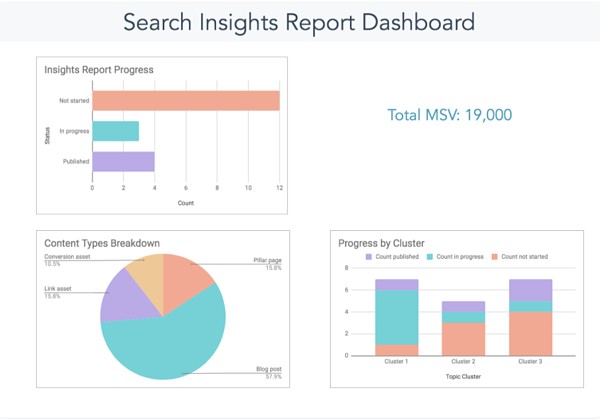When I used to work at a marketing agency, I would read expert industry blogs, such as HubSpot, Marketing Brew, and Backlinko (to name a few).
One of my main questions every day was, "How do these brands do it? How do they constantly come up with brilliant blog ideas?"
Now, obviously, I work at HubSpot and I know what a blog strategy looks like at a big company with a recognizable brand.
By taking the time to do solid research and idea brainstorming, you can come up with blog topics that drive thousands of readers, like me, in -- while boosting traffic, authority, and credibility.
Today, I want to pull the curtain back for you. We'll discuss how the HubSpot blog continuously comes up with high-performing blog ideas.
How the HubSpot Blog Comes Up With Ideas
Before we get started, it's important to know that when the HubSpot team comes up with blog ideas, several teams are involved (SEO, blog, and lead generation). Because of this, we divide our brainstorming process into two parts: trend research and SEO topic research. We then combine these efforts in our Insights Report on a quarterly basis (which you can download a copy of below).
Featured Resource: Search Insights Report Template
Let's dive into both those processes below.
How the HubSpot Blog Generates Trend-Responsive Blog Post Ideas
Blog topics that relate to trends, research, or thought leadership yield bursts in non-organic traffic that can help you gain visitors while you're waiting for SEO-driven posts to rank. Because they often include data, quotes, or other exclusive information, these posts can also earrn backlinks, which indirectly boost your search authority.
However, finding trendy non-organic post topics isn't always straightforward and often requires brainstorming.
Pamela Bump, HubSpot's Audience Growth Manager, leads the charge with our team's brainstorming efforts while also managing the blog's non-organic content strategy.
She says, "While our SEO team uses specialized tools to identify blog posts that will pull in organic traffic, I leverage a number of trend research tactics to identify post ideas that will pull in non-organic traffic from sources like email, social media, and referrals."
Below is the process she asks bloggers to use during our virtual idea brainstorms.
1. Focus on your blog categories.
Before you get started, it's important to have some sort of road map in mind. Choose the most important clusters, or blog categories, that you want to focus on for the quarter and develop ideas around them.
Immediately, just knowing the clusters you want to focus on could spark a few ideas for thought-leadership or data-driven research posts.
Each quarter, the HubSpot acquisition team chooses seven to ten clusters for each blog property -- for us, that's marketing, sales, service, and website. Usually the clusters relate to things like business goals or industry trends.
Additionally, we include other categories besides those clusters, such as Audience Growth, Lead Acquisition, and User Acquisition to help us brainstorm topics that are related to our lead generation goals.
2. Review the content you've already written to inspire new topics.
Now that you've done a quick brainstorm of some new ideas, let's see what's already been written in each cluster that you're focusing on.
To do this, search your site for the cluster. We do site searches at HubSpot, but just typing in "site:blog.hubspot.com/service customer experience" in Google. With this formatting, you can change the link and change the keyword to be whatever you're looking for. Then, Google will find posts on that keyword on that site specifically.
When you're coming up with blog ideas, searching the site to see if the topic has been covered is very important. The reason you'll want to do this is that you can find high-performing posts that give you inspiration for new angles or you can find posts that you want to update with more quotes, data, or new research. Additionally, this will help you avoid keyword cannibalization.
Caroline Forsey, the HubSpot Marketing Blog property manager, says. "Think of different angles for popular topics you've already covered. For instance, let's say you have plenty of content regarding LinkedIn — but you have none from a thought leader in the space. Perhaps you could conduct an interview with a LinkedIn employee for a thought leadership angle, like 'Top X Tips from a LinkedIn Marketer'."
3. See what the competition is doing.
While you never want to copy your competitors, it's important to see what topics they're writing about. This will help you fill in gaps that your competitors are missing and perhaps improve on blog topics they're discussing.
This also lets you know what's going on in your industry. What's the latest news and should you be writing about it?
Additionally, you can browse social media for this reason as well. Social media can let you know the pain points of your audience and check-in with what's going on with your target audience.
Staying up on industry news is one of the best ways to brainstorm blog ideas.
Forsey adds, "When new features become available for a social media platform or tool, there's often plenty of opportunities to explore new angles there, as well — recently, LinkedIn released its own version of Stories, so perhaps you brainstorm a topic like ‘X Best LinkedIn Stories We've Seen', or ‘LinkedIn, Instagram, or Facebook Stories: Which is Best?'"
4. Have a checklist of blog topic idea criteria.
Once you've created some blog ideas, you should check and make sure each blog post topic is aligned with your overall blog criteria. If you don't have blog criteria yet, maybe it's time to set some standards around what each blog topic should cover.
For example, at HubSpot, all our blog posts need to provide value to your blog audience, align with a cluster or lead-gen goal, provide non-organic opportunities, be either trend-responsive or evergreen, and have some keyword opportunities.
5. Stay organized.
You should track your blog ideas in an organized fashion. At HubSpot, we use an idea generation spreadsheet where writers and editors can brainstorm ideas for quarterly clusters, or just write down ongoing ideas.
Ultimately, this process helps keep us organized when it comes to generating consistent blog post ideas.
Jay Fuchs, a blog writer at HubSpot, describes his process. He says, "I try to find topics that reconcile engaging subject matter with practicality when coming up with research or trend-based blog topics. That means finding buzzy, intriguing subject matter that lends itself to an article with a compelling title, interesting supporting materials, and — perhaps most importantly — actionable advice."
Fuchs explains, "That could mean a piece about something like avoiding common pricing mistakes or sales strategies that will become prominent in the near future. One way or another, you need to pick topics that hook and help — ones that command your reader's attention and let you make the most of it with insight that they'll be able to apply, going forward."
Now that you know the HubSpot process when it comes to generating non-organic blog ideas, let's dive into the SEO side.
Brainstorming SEO-Optimized Ideas
While Bump and the blog writers brainstorm non-organic ideas, our SEO team is hard at work creating blog topics that have an organic goal in mind. This is their process:
1. Look at your company's products, goals, and customer base.
To start, HubSpot's SEO team will review our products, goals, and customer base.
Amanda Kopen, an SEO Strategist at HubSpot, says, "When coming up with blog post ideas, first you need to look at your company's products, goals, and customer base. At HubSpot, we brainstorm blog posts as they relate to our different products (marketing, sales, service, etc.). Then, we narrow it down to topics where we have expertise but are potential pain points for our customers (social media marketing)."
During this phase, our SEO team is reviewing our personas, prioritizing blog clusters (decided by SEO and lead-gen teams), and brainstorming what would be helpful to our audience.
Additionally, the SEO team will identify large topics, underperforming topics, and old but high-performing topics.
2. Conduct keyword research and run a content gap analysis.
After the initial brainstorm, it's time to do your keyword research and content gap analysis.
Kopen explains, "Once we have a potential pain point in mind, we use SEO best practices -- like conducting keyword research and running content gap analyses -- to see exactly what people want to learn about (how often should I post on LinkedIn), and we start writing from there."
During this part of the process, our SEO team will gather domains with similar audiences and conduct a content gap analysis (find out what these sites are ranking for that HubSpot isn't).
We'll also look at related searches on Google to see what people are searching for. Then, we'll identify opportunities where we can update old blog posts or recycle the URL (so we don't lose the SEO juice, but have updated content for that topic).
3. See if there are any linking opportunities.
Finally, the SEO team will also communicate with HubSpot's product and academy teams to see if there are linking opportunities such as any courses or products of ours we should be linking to.
Creating Traffic-Generating Ideas
And that's how the HubSpot blog comes up with high-performing blog post ideas consistently. To learn more about our process, you can learn how SEO works for the HubSpot Blog with our Insights Report course on HubSpot Academy.


